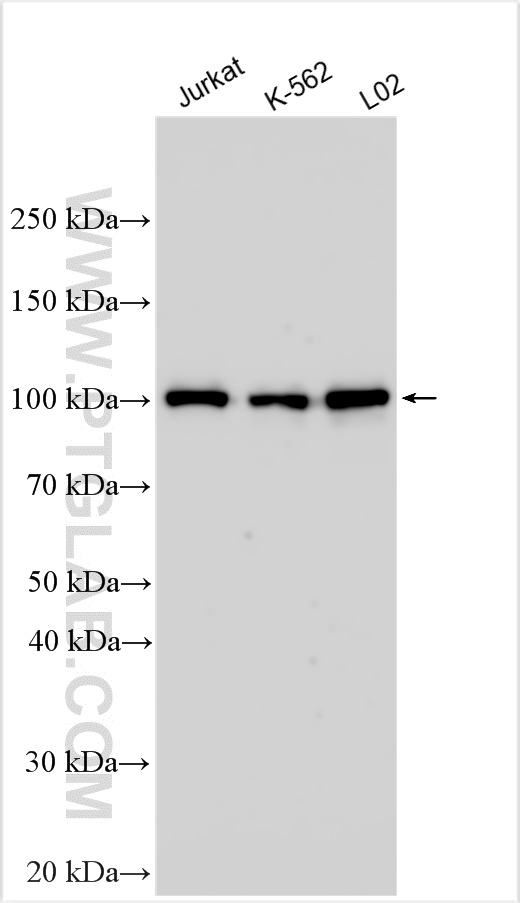验证数据展示
经过测试的应用
| Positive WB detected in | Jurkat cells, K-562 cells, L02 cells |
推荐稀释比
| 应用 | 推荐稀释比 |
|---|---|
| Western Blot (WB) | WB : 1:1000-1:4000 |
| It is recommended that this reagent should be titrated in each testing system to obtain optimal results. | |
| Sample-dependent, Check data in validation data gallery. | |
产品信息
13047-1-AP targets DDX11 in WB, ELISA applications and shows reactivity with human samples.
| 经测试应用 | WB, ELISA Application Description |
| 经测试反应性 | human |
| 免疫原 |
CatNo: Ag3666 Product name: Recombinant human DDX11 protein Source: e coli.-derived, PGEX-4T Tag: GST Domain: 1-345 aa of BC011264 Sequence: MANETQKVGAIHFPFPFTPYSIQEDFMAELYRVLEAGKIGIFESPTGTGKSLSLICGALSWLRDFEQKKREEEARLLETGTGPLHDEKDESLCLSSSCEGAAGTPRPAGEPAWVTQFVQKKEERDLVDRLKAEQARRKQREERLQQLQHRVQLKYAAKRLRQEEEERENLLRLSREMLETGPEAERLEQLESGEEELVLAEYESDEEKKVASRVDEDEDDLEEEHITKIYYCSRTHSQLAQFVHEVKKSPFGKDVRLVSLGSRQNLCVNEDVKSLGSVQLINDRCVDMQRSRHEKKKGAEEEKPKRRRQEKQAACPFYNHEQMGLLRDEALAEVKDMEQLLALGK 种属同源性预测 |
| 宿主/亚型 | Rabbit / IgG |
| 抗体类别 | Polyclonal |
| 产品类型 | Antibody |
| 全称 | DEAD/H (Asp-Glu-Ala-Asp/His) box polypeptide 11 (CHL1-like helicase homolog, S. cerevisiae) |
| 别名 | ATP-dependent DNA helicase DDX11, CHL1-related protein 1, DDX 11, DEAD/H-box protein 11, EC:3.6.4.12 |
| 计算分子量 | 970 aa, 108 kDa |
| 观测分子量 | 102-108 kDa |
| GenBank蛋白编号 | BC011264 |
| 基因名称 | DDX11 |
| Gene ID (NCBI) | 1663 |
| 偶联类型 | Unconjugated |
| 形式 | Liquid |
| 纯化方式 | Antigen affinity purification |
| UNIPROT ID | Q96FC9 |
| 储存缓冲液 | PBS with 0.02% sodium azide and 50% glycerol, pH 7.3. |
| 储存条件 | Store at -20°C. Stable for one year after shipment. Aliquoting is unnecessary for -20oC storage. |
背景介绍
DDX11 (DEAD/H-box helicase 11), also known as hCHLR1, KRG-2, is a member of the DExD/H (Asp-Glu-x-Asp/His)-box helicase family containing DNA helicase with roles in DNA replication and sister chromatid cohesion establishment, and general chromosome architecture (PMID: 33802088). DDX11 encodes an iron-sulfur cluster DNA helicase required for development, mutated, and overexpressed in cancers (PMID: 33879618). DDX11 is also a positive regulator of the RIG-I-mitochondrial antiviral signaling protein (MAVS)-mediated signaling pathways (PMID: 39470258).
实验方案
| Product Specific Protocols | |
|---|---|
| WB protocol for DDX11 antibody 13047-1-AP | Download protocol |
| Standard Protocols | |
|---|---|
| Click here to view our Standard Protocols |


